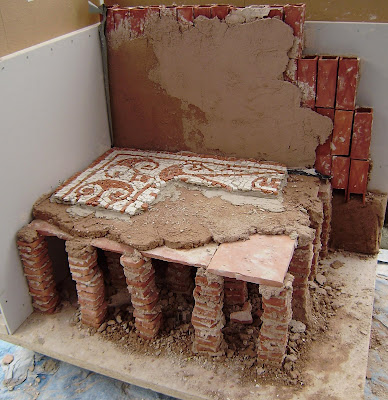 The hypocaust under construction
The hypocaust under constructionIt’s amazing what you can end up making as an historical potter: Children from several Skipton schools had some fun recently, when they assisted me in the rather unusual task of constructing a half scale Roman Hypocaust, or central heating system, on the pavement outside the Craven Museum on Skipton High Street. I had made and fired all the necessary parts; nearly over two hundred pilaster bricks, seventy tubular box tiles and innumerable tessarae for the floor mosaic, over the preceding few weeks and the children helped with tasks such as brick laying the pillars which support the floor, setting the floor slabs in place, constructing the walls from tubular box tiles and creating the mosaic to surface the floor. By Friday afternoon the construction phase was complete the mosaic had been set in place and all was ready for the final phase, lighting the fire and making it work. The weather obliged with a steady downpour which made the task more difficult but set the wintry atmosphere in which a centrally heated villa might seem right at home.
As the small charcoal fire beneath the floor crackled into life, the box flues drew the warm air up into the walls and modern temperature sensors recorded the steady rise in temperature above the floor seeing it soar to 120 degrees F, almost 50 degrees C. The model was so successful it has now been moved into the museum where it takes pride of place next to the architectural ceramic finds from the Kirk Sink Villa at Gargrave where it is helping to explain the function of the various artefacts.
Visit my website at www.pottedhistory.co.uk
